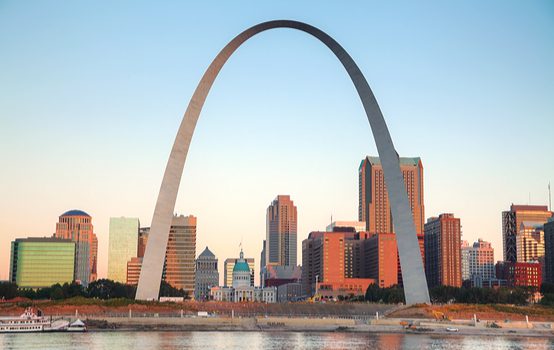Is Missouri Still a Bellwether?

This Sunday, Washington University in St. Louis will host its fifth presidential or vice-presidential debate in the last seven election cycles. (It would be the sixth, but a scheduled debate for 1996 was ultimately canceled.) I don’t pretend to know exactly what determines where the Commission on Presidential Debates holds its events, but I expect that Missouri’s reputation as a presidential bellwether at least partially explains why it was first selected back in 1992.
Missouri voted for the winner of the presidential election for the entire century from 1904 to 2004, with only the exception of 1956, when it voted for the former governor of neighboring Illinois, Adlai Stevenson. But in 2008 and 2012, the state broke against President Obama. The razor-thin 2008 margin of 0.14 percent—a mere 3,903 votes—could perhaps be written off as an aberration, but the nearly ten-point advantage for Romney in 2012 showed a state shading redder from its historic purple.
This cycle, Trump is expected to win Missouri decisively. Statistician Nate Silver, who correctly called every state in 2012, currently projects in his “polls-plus” forecast that Trump will win the Show-Me State by 7.3 points, compared to a 3.4 percent Clinton victory nationally. Similarly, the General Assembly seems to be under functionally permanent Republican control, with the GOP holding two-thirds supermajorities in both chambers.
However, the picture looks very different when we examine statewide offices. Republicans hold only the lieutenant governor’s office and one Senate seat. Republican Tom Schweich won election as auditor in 2014, but he committed suicide in early 2015 amidst an ugly gubernatorial primary fight. This allowed Democratic Gov. Jay Nixon to appoint Nicole Galloway to the post.
Several of those statewide offices are expected to go to Republican contenders on November 8, but most expect Democrats to retain the governorship and possibly flip the state’s Republican-held Senate seat. Attorney General Chris Koster, a Democrat who started his political career as a Republican in the legislature, is favored to defeat Republican gubernatorial candidate Eric Greitens, a former Navy Seal and political novice. Koster has spent his entire career building the sort of coalition that typically guarantees victory in Missouri, earning endorsements from both the Missouri Farm Bureau and the National Rifle Association, likely securing the support of typically Republican-leaning independents.
Secretary of State Jason Kander provides an even more interesting case in his challenge to Sen. Roy Blunt. After earning his law degree at Georgetown, Kander served as an Army National Guard officer in Afghanistan. He put that service to political use in a widely praised ad in which a blindfolded Kander assembles an automatic weapon as he vows to both protect the Second Amendment and support regulations such as criminal background checks.
Kander has also painted Blunt as a Washington insider—a charge that seems impossible for the incumbent to deny. Blunt’s wife and son both work as lobbyists, and he serves as vice-chair of the Senate Republican Conference. In this anti-establishment year, Blunt is frequently attacked as a hated member of “the establishment” by members of his own party. All this has moved the race to a tossup, with Silver giving Blunt only a 2.3-point advantage.
This raises the question: is it really true that Democrats can no longer compete in Missouri at the presidential level, or is that the most recent Democratic nominees in particular cannot compete in Missouri?
Simple demographics can explain a great deal of this puzzle. As Democrats began to rely more heavily on minority groups in their presidential-election coalitions, states with large black and Hispanic populations became more prominent battleground states. Although African-Americans make up 11.5 percent of Missouri’s presidential-year electorate—very close to the national average of 13 percent—only 1.8 percent of the electorate is Hispanic, compared to 8.9 percent nationally. When Democrats lose with white voters as a whole, they will struggle in any state where over 80 percent of the voters are white.
True, there are other states where whites make up an even larger percentage of the electorate than they do in Missouri—and Clinton still holds decent-to-large leads over Trump in places such as Minnesota and Wisconsin. However, these states either have a much higher percentage of residents with a college degree or a lower percentage of the white population who identify as evangelical Protestants, or both.
What defines Democrats who succeed in Missouri statewide is their ability to appeal to independent white voters. Accordingly, they typically hold more conservative positions on hot-button issues such as guns and criminal justice. They typically come from either a prosecutorial background (Nixon and Koster) or military service (Kander) and make note of it frequently.
Could a similar Democratic presidential candidate win in Missouri? Probably, but it’s unlikely that he could win the nomination of the party. The progressive base would find him unappealing. We need look no farther than the doomed candidacy of Jim Webb this year to see how such a candidate would fare at the national level. Furthermore, there are many, far easier paths to 270 electoral votes for Democratic candidates, none of which run through Missouri.
Missouri has trended more Republican in the last decade, but the idea that it is now a solidly red state is a myth. It tilts right, but it remains a purple state—just not in presidential elections.
John Payne is the campaign manager for New Approach Missouri, an initiative campaign for medical marijuana. He resides in St. Louis.
Comments